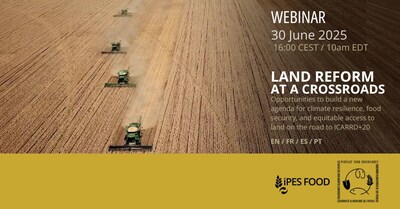Reuters | Wed Sep 23, 2009
- Owning land seen as inflation hedge
- Changing global diet underpins farmland investment By Rod Nickel WINNIPEG, Manitoba, Sept 22 (Reuters) - People need to eat, and investors who own cropland may be poised to profit from that most basic need. Investing in farmland is gaining traction as the farm sector strengthens, and it offers several ways to make money. The owner can lease the land back to the farmer for a steady income, and make a profit when land prices rise. Or an investor group can farm the land itself, taking advantage of economies of scale. "I think we're just getting started on this (type of investment)," said Greg Colman, an analyst at Wellington West Capital Markets in Toronto. "The supply-demand dynamics are going to naturally drive up the price of the producing asset, the arable land." Underpinning the idea of investing in farmland is the belief that as emerging countries such as India and China grow, so does the value of farmland. Demand for higher-protein diets in those countries will boost long-term prospects for grain -- which farmers grow mostly to feed livestock -- and help companies that rely on selling farm machinery and crop inputs. Although farm analysts believe rising demand in the developing world is a long-term trend, farmland investments are not without risk. History has shown agriculture to be one of the most cyclical of industries. There were times within the past decade when many farmers themselves considered their land worthless. Grain prices were weak, farmers struggled to make a living and the resale value of their land was negligible. Assiniboia Capital Corp, a fund that's open to individual and institutional investors, is betting those days will not return quickly. It has assembled 90,000 acres of Saskatchewan farmland and sees profit in both renting the land to farmers and in longer-term capital appreciation. Farmland provides investors a hard asset to hedge against inflation, while realizing a year-over-year profit, said Doug Emsley, president of Assiniboia. "Gold's good, but gold doesn't draw income," he said. Assiniboia, based in Regina, Saskatchewan, typically makes a 5 percent annual cash distribution, in line with the return from corporate farms that own and farm their land, he said. Colman sees owning the land as key, especially as the volatile world economy boosts the need for a safe hedge. He said the model of owning farmland and operating it suits long-term, low-risk investors, noting that most investments so far have been from institutions. The downside is that farmland investments provide little chance of a quick exit, unlike more liquid holdings, Colman said. And he advises farmland investors to diversify geographically to offset political or weather-related risk. Toronto-based Sprott Resource Corp is also bullish on farmland, but is not interested in owning it. The company has spent C$27.5 million ($25.7 million) to launch One Earth Farms Corp, a partnership with aboriginal groups in Western Canada that leases land and farms it. One Earth farmed an estimated 12,000 acres this summer, its first growing season, said Marc Robinson, a research analyst at Cormark Securities, but it intends to eventually scale up to a 1 million acre grain and cattle farm. "The nice thing about leasing is you do have a lot of capital required, but it's not as much capital at risk because you don't own the land," Robinson said. He said large-scale farming should produce savings the average farmer can't realize, along with ways to boost revenue. In a good year, a small farm could see a percentage profit in the low double digits, while the upside for a corporate farm likely exceeds 20 percent, Robinson said. ($1=$1.07 Canadian) (Editing by Janet Guttsman)











